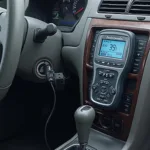OBD2 maintenance codes, also known as service reminders, are an essential part of your vehicle’s diagnostic system. They alert you to upcoming scheduled maintenance based on mileage or time, helping you keep your car running smoothly and avoid costly repairs down the line. These codes differ from diagnostic trouble codes (DTCs) which indicate a specific malfunction. Understanding these maintenance reminders can empower you to stay on top of your car’s health and budget.
Decoding OBD2 Maintenance Codes: A Comprehensive Guide
OBD2 maintenance codes are not universal. They vary depending on the vehicle manufacturer. Unlike DTCs, which follow a standardized format, these codes can be proprietary. This means a code might signify something different in a Ford compared to a Honda. However, they generally revolve around routine maintenance tasks such as oil changes, filter replacements, and spark plug checks. Knowing what these codes indicate can save you time and money.
Why are OBD2 Maintenance Codes Important?
Preventative maintenance is key to extending the life of your vehicle. OBD2 maintenance codes act as your car’s built-in reminder system, prompting you to address routine tasks before they become major problems. Ignoring these codes could lead to decreased performance, fuel inefficiency, and ultimately, expensive repairs. Regularly checking and addressing these codes helps ensure optimal performance and can prevent unexpected breakdowns.
Common OBD2 Maintenance Codes and Their Meanings
While the specific codes vary, some common maintenance tasks are often flagged by the OBD2 system:
- Oil Change: This is perhaps the most frequent maintenance reminder. It alerts you when it’s time for an oil change based on mileage or time elapsed since the last service.
- Filter Replacement: This code can indicate the need to replace various filters, including air, fuel, and cabin air filters.
- Spark Plug Replacement: Spark plugs play a crucial role in the combustion process. This code reminds you to replace them at the manufacturer-recommended intervals.
- Transmission Service: This code indicates the need for transmission fluid changes or other transmission-related maintenance.
- Coolant Flush: This code reminds you to flush and replace your vehicle’s coolant to prevent overheating.
How to Read OBD2 Maintenance Codes
Reading OBD2 maintenance codes requires an OBD2 scanner. These scanners are readily available and range from basic handheld devices to sophisticated professional tools. Simply plug the scanner into your car’s OBD2 port, usually located under the dashboard on the driver’s side, and follow the instructions provided with your specific scanner model. Many newer scanners also provide definitions for the codes, making it easy to understand what needs attention.
 OBD2 Scanner Connected to Car Port
OBD2 Scanner Connected to Car Port
“Regularly checking your OBD2 maintenance codes is a simple yet powerful way to stay ahead of potential car problems,” says automotive expert, Michael Stevenson, ASE Certified Master Technician. “It’s like having a personal mechanic whispering reminders in your ear.”
Resetting OBD2 Maintenance Codes
After completing the required maintenance, it’s essential to reset the corresponding codes. This can usually be done using the same OBD2 scanner you used to read the codes. Some vehicles also have specific procedures for manually resetting the codes without a scanner. Refer to your vehicle’s owner’s manual for specific instructions.
Staying Ahead of the Curve with OBD2 Maintenance
Understanding and utilizing obd2 maintenance codes is crucial for proactive vehicle care. By staying on top of these reminders, you can avoid costly repairs, maximize your vehicle’s lifespan, and ensure a smooth, safe driving experience.
“Don’t wait for a warning light to illuminate on your dashboard,” advises Sarah Johnson, Automotive Engineer at Vehicle Dynamics Inc. “Proactive maintenance using OBD2 codes is the smartest way to protect your investment.”
Conclusion
OBD2 maintenance codes are valuable tools for car owners. They offer a proactive approach to car maintenance, helping you avoid potential problems and keep your vehicle running smoothly. By understanding these codes and using an OBD2 scanner, you can take control of your vehicle’s maintenance schedule and enjoy peace of mind on the road. Remember to regularly check your obd2 maintenance codes as part of your routine car care.
FAQ
- What is the difference between OBD2 maintenance codes and DTCs? OBD2 maintenance codes are service reminders, while DTCs indicate specific malfunctions.
- Do all cars have OBD2 maintenance codes? Most modern cars have some form of OBD2 maintenance reminders, but the specific codes and implementation vary.
- Do I need a special scanner to read maintenance codes? Yes, an OBD2 scanner is required to read and reset maintenance codes.
- Can I reset maintenance codes myself? Yes, you can usually reset them with an OBD2 scanner or by following specific procedures outlined in your owner’s manual.
- What happens if I ignore maintenance codes? Ignoring maintenance codes can lead to decreased performance, fuel inefficiency, and eventually, costly repairs.
6.. Where can I find more information about my specific vehicle’s maintenance codes? Your vehicle’s owner’s manual is the best resource for specific information about your car’s maintenance codes. - How often should I check my OBD2 maintenance codes? It’s a good practice to check your maintenance codes every few months or as recommended in your owner’s manual.
Need help? Contact us via WhatsApp: +1(641)206-8880, Email: [email protected]. We have a 24/7 customer support team.

